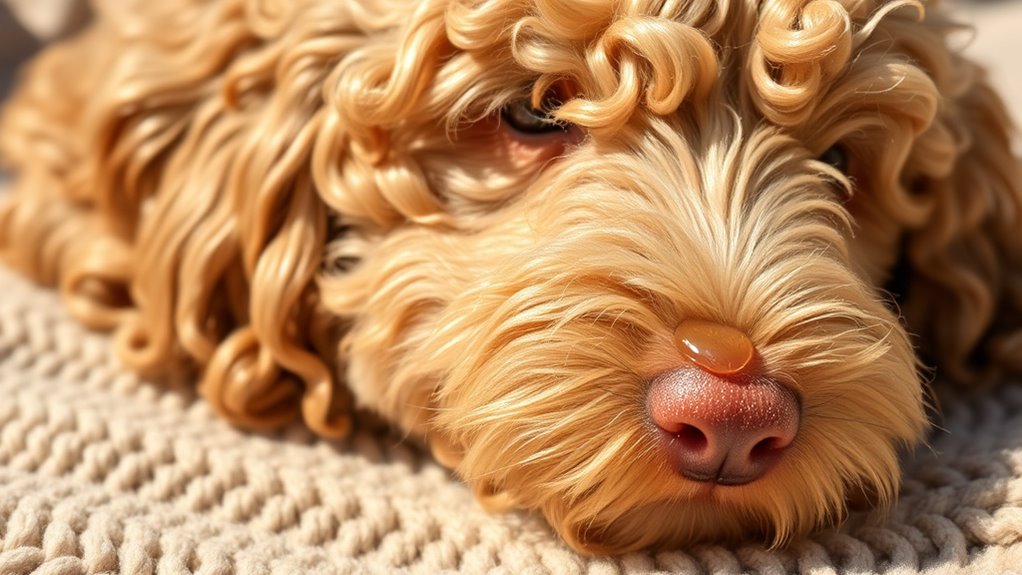Goldendoodles are not completely hypoallergenic, but their mixed coat types and good grooming habits can make them easier to manage if you have allergies. They tend to shed less, especially if they have wavy or curly coats inherited from Poodles. However, allergens from dander, saliva, and oils can still trigger reactions. To reduce your exposure, regular grooming, cleaning, and other allergy-friendly practices are essential—more tips to help you get started are right ahead.
Key Takeaways
- Goldendoodles produce fewer allergens than some breeds but are not completely allergy-proof.
- Coat type (curly, wavy, or straight) influences allergen levels and shedding.
- Regular grooming and cleaning can significantly reduce allergen buildup around Goldendoodles.
- Genetic factors from Poodle and Golden Retriever lineage impact their hypoallergenic qualities.
- Individual allergy sensitivities vary; consulting an allergist helps determine suitability.
Understanding What Hypoallergenic Means for Dogs

Many people assume that hypoallergenic dogs are completely allergy-proof, but that’s not entirely accurate. Hypoallergenic simply means these dogs tend to produce fewer allergens, such as dander and saliva, which can trigger allergies. Understanding what this really entails helps you set realistic expectations. Regular dog grooming is essential to minimize shedding and reduce airborne allergens. Implementing effective grooming practices can significantly decrease allergen exposure in your home. Using allergenic-reducing products can further help manage allergen levels indoors. Additionally, choosing breeds with lower allergen production can improve your overall experience. Consulting with an allergist can also help identify specific sensitivities and tailor your dog selection accordingly. Keep in mind, no dog is entirely allergy-free, but some breeds, like Goldendoodles, often produce fewer allergens. By maintaining a consistent grooming routine and consulting with an allergist, you can enjoy the companionship of a hypoallergenic dog while managing allergy symptoms effectively.
The Genetic Makeup of Goldendoodles and Coat Types

The genetic makeup of Goldendoodles plays a key role in determining their coat types, which can vary widely based on their parent breeds. Your Goldendoodle’s coat textures are influenced by genetic inheritance, affecting factors like curliness, wave, or straightness. To understand this better: 1. Coat textures depend on the specific genes inherited from the Poodle and Golden Retriever. 2. Curly, wavy, or straight coats are common, with each type having different grooming needs. 3. The presence of certain genes increases the likelihood of hypoallergenic traits, but coat type alone doesn’t guarantee allergy-friendliness. 4. Genetic inheritance plays a significant role in determining both coat type and potential allergenic qualities. Knowing your dog’s genetic background helps you anticipate coat behavior and maintenance, giving you insight into potential allergenic qualities linked to their coat types.
The Role of Dander, Saliva, and Skin Oils in Allergies

Dander, saliva, and skin oils are the primary substances that trigger allergic reactions in sensitive individuals. When your Goldendoodle sheds skin flakes (dander), these tiny particles become airborne or settle on surfaces, leading to allergy symptoms. Saliva from grooming or licking the coat contains pet allergens that transfer to skin and fur, further spreading allergens. Skin oils, naturally produced, also carry allergens that stick to hair and furniture. These substances are often more problematic than the fur itself because they contain proteins that trigger immune responses in allergy sufferers. Understanding how dander, saliva, and skin oils contribute to pet allergens helps you see why some people experience allergy symptoms even with hypoallergenic breeds. Managing these substances can reduce allergic reactions considerably. Regular cleaning and allergenic protein reduction strategies can help minimize exposure and improve comfort around the pet. Additionally, using air purifiers with HEPA filters can effectively capture airborne allergen particles, providing relief for allergy sufferers. Implementing dander control techniques such as bathing your Goldendoodle regularly can also significantly decrease allergen levels indoors. Moreover, understanding the immune response mechanisms involved can help allergy sufferers develop better management strategies.
Factors That Influence Allergic Reactions to Goldendoodles

Several factors can influence how strongly you or others react to Goldendoodles, even if they’re labeled hypoallergenic. First, grooming techniques play a significant role; regular brushing and trimming reduce loose hair and dander. Second, individual sensitivities vary, so allergy testing can help determine your specific triggers. Third, a Goldendoodle’s coat type impacts allergen levels; curly or wavy coats tend to trap dander better than straighter ones. Other considerations include the frequency of bathing and cleaning your home environment. Additionally, understanding the dog’s heritage and lineage can provide insights into potential allergen levels. Breeding practices that focus on coat quality can also influence allergen production. Moreover, the dog’s dander shedding patterns are crucial in understanding allergen dispersion in your home. The dander accumulation in your environment can further intensify allergic reactions. By understanding these factors, you can better manage allergic reactions. Remember, even with hypoallergenic breeds, these influences can affect your experience, so tailoring your approach based on grooming and allergy testing results is essential.
Tips for Managing Allergies While Owning a Goldendoodle

Managing allergies while owning a Goldendoodle requires proactive steps to minimize exposure to allergens. Regular grooming routines are essential; brush your dog frequently to reduce loose hair and dander. Consider bathing your Goldendoodle weekly with a gentle, allergy-friendly shampoo to keep allergens at bay. Keep your home clean by vacuuming often with a HEPA filter and washing your dog’s bedding regularly. Using allergy medications, such as antihistamines or nasal sprays, can help manage symptoms effectively. Create designated pet-free zones, especially in bedrooms, to limit allergen exposure where you sleep. Maintaining a consistent grooming routine and using high-quality products can significantly reduce allergen levels. Additionally, utilizing air purifiers with HEPA filters can help remove airborne allergens from your living space. Incorporating allergy-friendly home modifications can further improve your comfort and reduce symptoms. Being aware of allergenic materials in furniture and decor can also make a difference. Consistency is key; implementing these tips helps you enjoy your Goldendoodle while keeping allergy symptoms under control.
Frequently Asked Questions
Can Goldendoodles Still Trigger Allergies Despite Their Hypoallergenic Claims?
You might wonder if Goldendoodles can still trigger allergies despite their hypoallergenic claims. While they typically produce less dander, it’s possible for some to still cause reactions. To minimize allergy symptoms, focus on dander reduction strategies and consider allergy testing before bringing one home. Keep in mind that individual sensitivities vary, so even hypoallergenic breeds like Goldendoodles might not be completely allergy-free for everyone.
Are There Specific Coat Colors or Patterns More Allergenic in Goldendoodles?
When considering coat color and pattern allergies in Goldendoodles, you might wonder if certain options increase your allergy risks. While coat color and pattern don’t directly affect allergen levels, some coat types—like curly or wavy—may shed less, possibly reducing allergens. So, whether it’s a black, cream, or parti-patterned Goldendoodle, focusing on coat type rather than color or pattern helps manage your allergy concerns effectively.
How Does Grooming Frequency Impact Allergy Symptoms in Goldendoodle Owners?
Grooming routines greatly impact allergy symptoms in Goldendoodle owners by reducing dander. Regular brushing and professional grooming help remove loose hair and skin flakes that carry allergens. By maintaining consistent grooming, you can minimize allergen buildup, making it easier to breathe and reducing allergy flare-ups. Proper grooming routines are essential for controlling allergens, especially if you’re sensitive, and can make sharing your home with your Goldendoodle more comfortable.
Do Goldendoodle Puppies Have Different Allergen Levels Compared to Adult Dogs?
You might wonder if Goldendoodle puppies have different allergen levels compared to adults. Generally, puppies tend to produce less dander and shed less coat, which can mean lower allergen levels initially. However, as they grow, their coat changes and shedding may increase, potentially affecting dander levels. Regular grooming can help reduce allergen buildup, regardless of age, making Goldendoodles more comfortable for allergy sufferers over time.
Are Certain Goldendoodle Generations More Allergy-Friendly Than Others?
You might wonder if certain Goldendoodle generations are more allergy-friendly. The answer isn’t straightforward—some generations, like F1b or F2b, often shed less, reducing allergens. Yet, their doodle temperament and grooming routines play vital roles. Regular grooming can minimize dander, making allergy management easier. So, if you’re sensitive, choosing specific generations and maintaining consistent grooming might just make the difference between a sneeze and a smile.
Conclusion
Think of owning a Goldendoodle like tending a delicate garden. While they’re often called hypoallergenic, it’s your care and understanding that truly determine if they’re right for you. With patience, regular grooming, and love, you can create a harmonious bond—like nurturing a rare flower—bringing beauty and joy into your life. Remember, every pet is unique, but your dedication can turn the challenges into a blossoming friendship.










